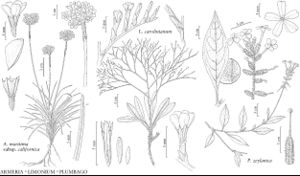Herbs or shrubs [lianas], perennial or, rarely, annual; taprooted or rhizomatous. Stems woody stocks, acaulescent, or erect to prostrate, nodes swollen; indument of simple hairs, capitate glands that may secrete water or calcium salts, or multicelled glandlike structures. Leaves often basal, alternate, spiralled; stipules absent; petiole present or absent; blade linear to broadly obovate, ovate, or round, margins entire or lobed. Inflorescences terminal or axillary cymes, panicles, racemes, or corymbs, or solitary heads; bracts herbaceous, scarious, sometimes absent; involucral bracteoles (epicalyces) immediately subtending calyces usually present. Pedicels absent or present (short). Flowers bisexual, radially symmetric; perianth and androecium hypogynous; sepals persistent in mature fruits, 5, connate into 5- or 10-ribbed tube, mostly dry and membranous, sometimes petaloid, toothed or with distinct simple or lobed limbs; petals 5, nearly distinct, connate at bases or for most of their length (corolla salverform); blade clawed or claw absent, margins entire; corona absent; stamens 5; filaments adnate to bases of petals or free; ovary superior, 1-locular, placentation basal; ovules 1 per ovary, anatropous, bitegmic, crassinucellate; styles 1 with apically lobed stigma, or 5, each with linear stigma. Fruits utricles, achenes, or capsules. Seeds 1, embryo straight, endosperm present or absent.
Distribution
Worldwide, especially maritime areas.
Discussion
Genera 24, species ca. 775 (3 genera, 11 species in the flora).
A report of Ceratostigma plumbaginioides Bunge from Missouri is based on a single specimen collected in an alley in Columbia, Boone County (D. B. Dunn 1982) and probably is not naturalized, according to George Yatskievych (pers. comm.), who considers that it probably has not persisted. J. H. Schaffner (1932) reported the same species as a waif in Lake County, Ohio. T. C. Cooperrider (1995) cited that report and indicated that he had not seen a specimen. Cultivated Ceratostigma seems to have the potential for becoming naturalized. Ceratostigma resembles Plumbago but has stamens adnate to the corolla tube and a nonglandular calyx.
Plumbaginaceae may be a sister group to Polygonaceae (M. D. Lledó et al. 1998). It includes some plants of horticultural value, including Ceratostigma, Armeria, Limonium, and Plumbago. Some species of Plumbago and Limonium have medicinal uses. Plumbaginaceae often occur in saline habitats; basal leaves may have glands that excrete calcareous or chalklike salts. Some species of Armeria occur on soils rich in lead or on mine tailings. The family’s Latin and common names derive from an early belief that the plants could cure lead poisoning.
Selected References
Illustrations
| Family ⠉ | Taxon | Illustrator ⠉ | |
|---|---|---|---|
 | Plumbaginaceae Plumbaginaceae Plumbaginaceae | Armeria maritima Limonium carolinianum Plumbago zeylanica | John Myers John Myers John Myers |
Key
| 1 | Inflorescences dense hemispheric heads terminal on leafless scape; leaf blades mostly linearto lanceolate | Armeria |
| 1 | Inflorescences terminal or axillary racemes, panicles, or corymbs; leaf blades elliptic to oblong to round, rarely linear | > 2 |
| 2 | Plants acaulescent; petals nearly distinct; stamens adnate to bases of petals | Limonium |
| 2 | Plants with stems erect, prostrate, or climbing; petals connate for most of their length, corollas salverform; stamens free from petals | Plumbago |